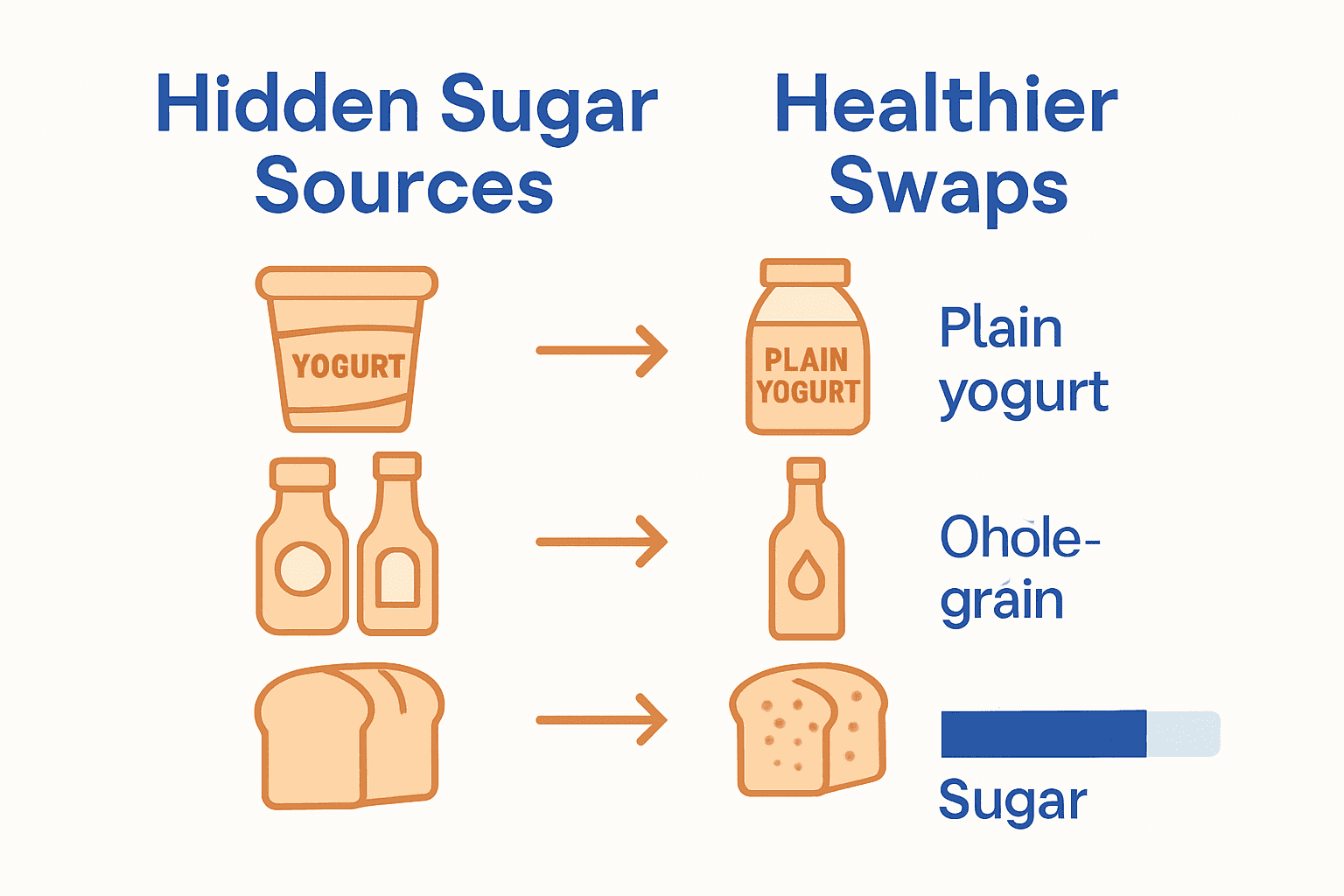Most adults consume about 17 teaspoons of added sugar every day, far beyond the recommended limits.
This much sugar can quietly sabotage even the best weight loss intentions and leave many people feeling frustrated. Taking a closer look at where hidden sugars creep into your daily diet is the first real step toward lasting change.
With clear guidance on how to assess, reduce, and replace excess sugar, you can start seeing real progress toward your health and weight goals.
Table of Contents
- Step 1: Assess Current Sugar Intake
- Step 2: Identify Hidden Sugars in Your Diet
- Step 3: Replace Sugary Foods with Healthier Options
- Step 4: Adopt Sustainable Eating Habits
- Step 5: Monitor Progress and Adjust Your Plan
Quick Summary
| Key Point | Explanation |
|---|---|
| 1. Track Your Sugar Intake | Assess your current sugar consumption by analyzing food labels and tracking your intake for one week. |
| 2. Identify Hidden Sugars | Learn to spot hidden sugars on ingredient lists, such as terms ending in ‘-ose’ and common synonyms. |
| 3. Replace with Healthy Alternatives | Swap out sugary foods for nutritious options, like choosing plain yogurt with fruits instead of sweetened varieties. |
| 4. Develop Sustainable Habits | Focus on gradual, mindful changes in your eating habits to promote long-term health and weight management. |
| 5. Monitor Progress Regularly | Keep a detailed food journal to track changes in your sugar intake and adjust your plan as needed. |
Step 1: Assess Current Sugar Intake
Before you can reduce sugar and achieve lasting weight loss, you need to understand your current sugar consumption. This step involves carefully tracking and analyzing the sugar you consume daily.
According to CDC, identifying hidden sugars in everyday foods is crucial for making informed dietary choices.
Start by examining the nutrition labels of everything you eat and drink. Johns Hopkins Medicine recommends looking beyond just the “sugar” line and understanding the various names added sugars can take.
Watch for terms like corn syrup, dextrose, fructose, maltose, and sucrose all indicate additional sugar content. Create a food diary for one week tracking your total sugar intake including obvious sources like sodas and desserts and sneaky sources like sauces, dressings, and processed foods.
Pro tip: Most adults consume around 17 teaspoons of added sugar daily far exceeding the recommended 6 teaspoons for women and 9 for men. By meticulously tracking your intake you will gain valuable insights into your current eating habits and potential areas for reduction.
This assessment is your first powerful step toward naturally reducing sugar and supporting your weight loss journey.
Step 2: Identify Hidden Sugars in Your Diet
Now that you have started tracking your sugar intake, it is time to become a detective and uncover the hidden sugars lurking in your diet.
CDC recommends learning specific strategies to spot these sneaky sugar sources by carefully examining ingredient lists for terms that might indicate added sugars.
Johns Hopkins Medicine highlights that hidden sugars can appear in unexpected places.
Watch for ingredients ending in ‘-ose’ like glucose, fructose, and sucrose, as well as common sugar synonyms such as corn syrup, rice syrup, honey, molasses, and fruit juice concentrates. Pay special attention to processed foods like condiments, salad dressings, bread, pasta sauces, and seemingly healthy items like yogurt and granola bars.
Pro tip: A food item with multiple sugar types listed in the first few ingredients is a red flag. Checking nutrition labels is crucial for understanding your actual sugar consumption.
Learning to decode these labels will empower you to make smarter dietary choices and support your natural weight loss goals.
 Consider sugar addiction solutions for deeper strategies in managing your sugar intake effectively.
Consider sugar addiction solutions for deeper strategies in managing your sugar intake effectively.
Step 3: Replace Sugary Foods with Healthier Options
Transforming your diet means strategically swapping out sugar-laden foods for nutritious alternatives that support your weight loss goals.
CDC recommends focusing on substituting sugary products with unsweetened versions and adding natural sweetness through whole fruits.
Johns Hopkins Medicine suggests practical replacements like choosing plain yogurt and adding fresh berries instead of buying pre-sweetened varieties. Start by gradually replacing processed snacks with whole food options.
Swap sugary breakfast cereals for steel cut oats with cinnamon, replace soda with sparkling water infused with fresh fruit slices, and choose dark chocolate over milk chocolate.
When craving something sweet, reach for healthy alternatives to snacks that provide nutritional value without excessive sugar.
Pro tip: Read labels carefully and aim for foods with less than 5 grams of added sugar per serving. Remember that your taste buds will adjust over time.
The key is making sustainable changes that feel natural and enjoyable, transforming your relationship with food while supporting your weight loss journey.

Step 4: Adopt Sustainable Eating Habits
CDC emphasizes that sustainable weight loss is not about drastic changes but gradual, mindful adjustments to your eating habits. Reducing sugar intake requires a long-term strategy that feels natural and enjoyable rather than restrictive or punishing.
Johns Hopkins Medicine recommends developing consistent habits that support your health goals. Start by creating a weekly meal plan that incorporates whole foods, lean proteins, and complex carbohydrates.
Practice portion control by using smaller plates, eating slowly, and listening to your body’s hunger signals. Learn to read nutrition labels carefully and make informed choices about the foods you consume.
Consider understanding what is a sustainable diet for long term health and weight management.
Pro tip: Progress is not linear. Some days will be easier than others, and that is okay. The goal is consistency over perfection.
By making small, incremental changes and being kind to yourself, you will gradually transform your relationship with food and support your natural weight loss journey.
>>> Want to Learn How I “Quit My Sugar Cravings” and “Lost Weight” Naturally??? Click Here to Find Out! <<<
Step 5: Monitor Progress and Adjust Your Plan
CDC emphasizes that successful weight loss requires consistent monitoring and strategic adjustments. Tracking your sugar reduction journey is not about perfection but understanding your body’s unique responses and creating a personalized approach that works for you.
Johns Hopkins Medicine recommends developing a systematic approach to monitoring your progress. Keep a detailed food journal documenting your daily sugar intake, energy levels, and how you feel after meals.
Take weekly measurements including weight, body measurements, and energy levels.
Look for patterns and be ready to make small modifications to your diet and exercise routine.
Consider how to track fitness progress consistently to maintain motivation and accountability.
Pro tip: Your body is dynamic and constantly changing. What works today might need adjustment tomorrow.
Stay flexible, patient, and kind to yourself. Regular reflection and gentle course correction are the keys to sustainable weight loss and improved health.
Take Control of Your Sugar Intake and Transform Your Weight Loss Journey
Struggling with hidden sugars sabotaging your efforts to lose weight naturally is a common challenge.
This article revealed how important it is to identify sugar sources, understand nutrition labels, and replace sugary foods with healthier options for lasting results.
If you are ready to overcome poor nutrition and build sustainable habits that truly work for you explore our expert-backed guidance in Poor Nutrition – LeanAndFit and discover practical strategies to beat sugar cravings and improve your diet.

Take the next step to support your natural weight loss goals by visiting https://leanandfit.info.
Dive into our comprehensive resources including the Best Lean & Fit Methods – LeanAndFit category for effective lifestyle changes.
Act now to reclaim your health and break free from sugar’s hold with trusted advice designed to fit your life. Your path to a leaner, healthier you starts here.
Frequently Asked Questions
Q-1: How can I assess my current sugar intake for weight loss?
A-1: To assess your current sugar intake, keep a food diary for one week, tracking everything you eat and drink, including sugar content. Analyze nutrition labels for hidden sugars and aim to identify both obvious and sneaky sources in your diet.
Q-2: What are the best strategies to identify hidden sugars in my diet?
A-2: To identify hidden sugars, carefully examine ingredient lists for terms that indicate added sugars, such as corn syrup or any ingredient ending in ‘-ose.’ Focus on processed foods like condiments and snacks, and choose items with fewer sugar types listed in the first few ingredients.
Q-3: How can I replace sugary foods with healthier options?
A-3: Begin replacing sugary foods with nutritious alternatives by choosing unsweetened products and adding natural sweetness from whole fruits. For example, swap pre-sweetened yogurt for plain yogurt with fresh berries to create a healthier snack.
Q-4: What sustainable eating habits should I adopt to reduce sugar intake?
A-4: Adopt sustainable eating habits by creating weekly meal plans that include whole foods and practicing portion control. Use smaller plates and eat slowly while listening to your body’s hunger signals to make mindful food choices.
Q-5: How do I monitor my progress while reducing sugar for weight loss?
A-5: Monitor your progress by keeping a detailed food journal documenting your sugar intake and how you feel after meals. Take weekly measurements of your weight and energy levels to identify any patterns and make adjustments as needed.
Q-6: What changes can I expect when reducing sugar naturally?
A-6: When you reduce sugar naturally, expect gradual improvements in energy levels, mood stability, and weight management. Give your body time, as it may take a few weeks to adjust; aim for about a 20% reduction in added sugars within the first month.
Leave a Reply